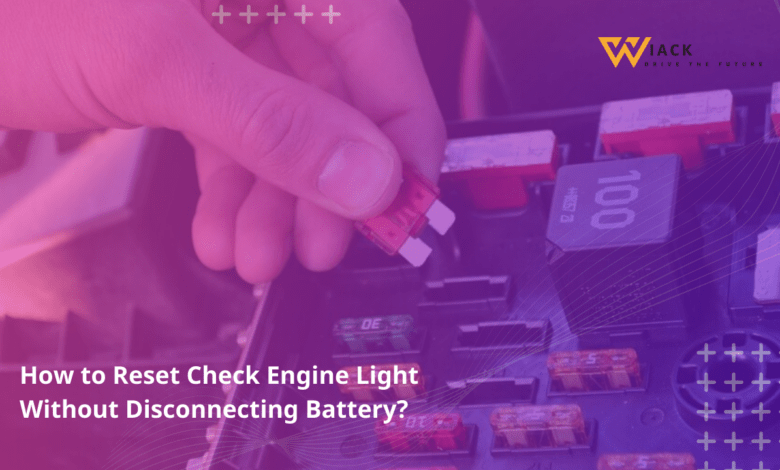How to Reset Check Engine Light Without Disconnecting Battery

Did you know that the check engine light can generate between 30,000 to 70,000 impressions daily on drivers? This surprising statistic highlights how common and potentially stressful this dashboard warning can be for vehicle owners. If you’ve recently fixed an issue with your car but the check engine light is still on, you might be wondering how to reset it without going through the hassle of disconnecting your battery. In this comprehensive guide, we’ll explore several methods to reset your check engine light without disconnecting the battery, providing you with practical solutions to this common automotive challenge.
Understanding the Check Engine Light
Before we dive into the reset methods, it’s crucial to understand what the check engine light is and why it illuminates. This knowledge will help you approach the reset process more effectively and ensure you’re addressing any underlying issues properly.
What is the Check Engine Light?
The check engine light, also known as the malfunction indicator lamp (MIL), is a warning signal on your vehicle’s dashboard. It’s typically represented by an engine-shaped icon or the words “Check Engine” or “Service Engine Soon.” This light is an integral part of your car’s onboard diagnostics system (OBD-II), which monitors various aspects of your vehicle’s performance and emissions control systems.
When the check engine light illuminates, it’s your car’s way of telling you that something isn’t quite right. It could be a minor issue, like a loose gas cap, or something more serious that requires immediate attention. The light is designed to alert you early, potentially preventing more severe damage to your vehicle if the problem is left unaddressed.
Why Does the Check Engine Light Come On?
There are numerous reasons why your check engine light might illuminate. Some of the most common causes include:
- Loose or faulty gas cap: A loose gas cap can cause fuel vapors to escape, triggering the check engine light.
- Oxygen sensor failure: This sensor monitors the amount of unburned oxygen in your vehicle’s exhaust system.
- Catalytic converter issues: Problems with this emissions control device can trigger the light.
- Mass airflow sensor malfunction: This sensor measures the amount of air entering the engine.
- Spark plug or ignition coil problems: These components are crucial for proper engine operation.
- Battery issues: A weak or failing battery can sometimes trigger the check engine light.
- Emissions control system faults: Various components in this system can cause the light to come on if they malfunction.
- Engine misfire: This can be caused by several factors, including faulty spark plugs or fuel injectors.
Understanding these potential causes is important because it emphasizes why you shouldn’t simply reset the check engine light without addressing the underlying issue. Always ensure that you’ve identified and fixed the problem before attempting to reset the light.
Methods to Reset the Check Engine Light
Now that we understand the basics of the check engine light, let’s explore several methods to reset it without disconnecting your battery. These techniques can be useful when you’ve already addressed the underlying issue but the light remains on.
Method 1: Use an OBD-II Scanner
One of the most reliable and professional ways to reset your check engine light is by using an OBD-II scanner. This device communicates directly with your vehicle’s onboard computer, allowing you to read and clear diagnostic trouble codes (DTCs).
Locate the OBD-II Port
First, you need to find your vehicle’s OBD-II port. This is typically located under the dashboard on the driver’s side of the car. In some vehicles, it might be hidden behind a small panel or cover.
Turn on the Ignition
Once you’ve located the port, turn your car’s ignition to the “On” position, but don’t start the engine. This powers up the vehicle’s electrical systems without running the engine.
Read the Trouble Codes
Connect your OBD-II scanner to the port. Follow the scanner’s instructions to read the trouble codes. These codes will give you specific information about what triggered the check engine light.
Clear the Trouble Codes
After you’ve read and noted the codes (in case you need them for future reference), use the scanner to clear the codes. This process varies depending on the scanner model, but there’s usually a clear option in the menu.
Turn off the Ignition
Once you’ve cleared the codes, turn off the ignition and disconnect the scanner. Wait for about 15 seconds before starting your car again.
Using an OBD-II scanner is highly effective because it communicates directly with your car’s computer system. However, if you don’t have access to a scanner, there are other methods you can try.
Method 2: Use the Trip Meter Reset Button
This method doesn’t work for all vehicles, but it’s worth trying if you don’t have an OBD-II scanner. It involves using your car’s trip meter reset button to potentially reset the check engine light.
Turn on the Ignition
As with the previous method, turn your car’s ignition to the “On” position without starting the engine.
Locate the Trip Meter Reset Button
Find the trip meter reset button on your dashboard. This is usually a small button near your odometer display.
Press and Hold the Trip Meter Reset Button
Press and hold down the trip meter reset button.
Start the Car
While still holding the reset button, start your car’s engine.
Continue Holding the Button
Keep holding the reset button for about 15 seconds after starting the engine.
Release the Button and Turn off the Ignition
Release the reset button and turn off the ignition. Wait for about 15 seconds.
Start the Car Again
Start your car again and check if the check engine light has reset.
This method relies on your vehicle’s specific computer system and may not work for all makes and models. If it doesn’t work for your car, don’t worry – there’s still another method you can try.
Method 3: Completing a Drive Cycle
Sometimes, your vehicle’s computer just needs to run through a complete drive cycle to reset the check engine light. This method takes longer than the others but can be effective, especially if you’ve recently fixed an issue.
Ensure the Issue Has Been Resolved
Before attempting this method, make sure you’ve addressed whatever problem initially triggered the check engine light. This method won’t work if there’s still an active issue with your vehicle.
Start Your Vehicle and Drive It Normally
Begin by starting your car and driving it as you normally would. The goal is to put your vehicle through its paces in various driving conditions.
Turn on the AC
After driving for a few minutes, turn on your air conditioning. This engages additional systems in your vehicle, which can help complete the drive cycle.
Drive Above 50 Miles per Hour
At some point during your drive, accelerate to highway speeds (above 50 mph) and maintain this speed for at least 15 minutes. This allows your vehicle’s systems to operate under higher load conditions.
Drive for Several Days or a Few Hundred Miles
Continue driving your vehicle normally for several days or a few hundred miles. This gives your car’s computer system enough time and data to determine if all systems are functioning correctly.
During this process, your vehicle’s computer will run through various self-tests. If all systems pass these tests, the check engine light should reset on its own.
Important Considerations
While these methods can be effective for resetting your check engine light, there are some important factors to keep in mind:
- Address the Underlying Issue: Always ensure you’ve fixed the problem that initially triggered the check engine light before attempting to reset it.
- Be Patient: Some methods, particularly the drive cycle method, can take time. Don’t get discouraged if the light doesn’t reset immediately.
- Consider Professional Help: If you’re unsure about what caused the check engine light or if these methods don’t work, it’s best to consult a professional mechanic.
- Check Your Vehicle’s Manual: Some cars may have specific procedures for resetting the check engine light. Always consult your owner’s manual for model-specific information.
Why Pulling a Fuse is Not Recommended
You might have heard that pulling a fuse can reset the check engine light. While this method can sometimes work, it’s not recommended for several reasons:
- Risk of Electrical Damage: Pulling the wrong fuse could potentially damage your vehicle’s electrical system.
- Loss of Important Data: Removing certain fuses can cause your car’s computer to lose valuable diagnostic information.
- Temporary Fix: Even if pulling a fuse does turn off the light, it often only does so temporarily. The light may come back on after a short time if the underlying issue hasn’t been resolved.
- Potential Safety Issues: Some fuses control critical safety systems. Removing these could compromise your vehicle’s safety features.
For these reasons, it’s best to stick to the methods outlined earlier in this article, which are safer and more reliable.
Conclusion
Dealing with a persistent check engine light can be frustrating, but as we’ve explored, there are several ways to reset it without disconnecting your battery. Let’s recap the most effective methods:
The Most Reliable Method
Using an OBD-II scanner remains the most reliable and professional way to reset your check engine light. It allows you to:
- Read specific trouble codes
- Clear these codes directly from your vehicle’s computer
- Ensure that the reset is complete and thorough
If you frequently work on your own vehicle, investing in an OBD-II scanner can be a wise decision. Many affordable options are available that can save you time and potentially costly trips to the mechanic for minor issues.
When to Seek Professional Help
While these DIY methods can be effective, there are times when it’s best to seek professional help:
- If the check engine light comes on frequently, even after resetting
- When you’re unable to identify or fix the underlying issue
- If your vehicle is experiencing performance problems along with the check engine light
- When you’re not comfortable performing car maintenance tasks yourself
Remember, the check engine light is an important safety feature designed to alert you to potential problems with your vehicle. Always take it seriously and address any underlying issues promptly to keep your car running smoothly and safely.
By understanding how to reset your check engine light without disconnecting the battery, you’re better equipped to handle this common automotive issue. However, always prioritize identifying and fixing the root cause of the problem to ensure your vehicle’s longevity and your safety on the road.
Get the latest car news, reviews, and prices at Wiack.com. Your one-stop destination for all things automotive.





